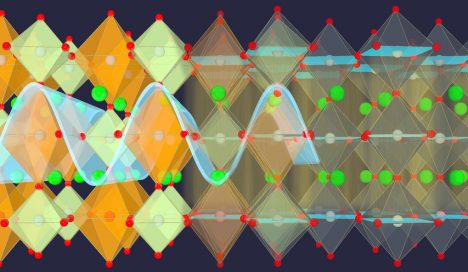A study led by scientists of the Max Planck Institute for the Structure and Dynamics of Matter (MPSD) presents evidence of the coexistence of superconductivity and “charge-density-waves” in compounds of the poorly-studied family of bismuthates. This observation opens up new perspectives for a deeper understanding of the phenomenon of high-temperature superconductivity, a topic which has been at the core of condensed matter research for more than 30 years.

Intense laser pulses were used to photo-excite bismuthate compounds, in which “charge-density-waves” (left side) coexist with superconductivity (right side). © J.M. Harms, MPSD
In the study, which has just been published in PNAS, the scientists around CUI member Prof. Andrea Cavalleri and Dr. Daniele Nicoletti focused on different compounds, belonging to the poorly studied family of bismuthates. These superconductors were discovered in the 1970s, even before the cuprates, the best known and heavily studied family of high temperature superconductor. Due to their far lower critical temperatures (about 30 K), however, bismuthates attracted less attention. They share many commonalities, but also some differences with their better-known relatives. In particular, the so-called “parent compound” BaBiO3 has a robust charge-density-wave phase, from which superconductivity emerges by chemical substitution.
High quality crystals of BaPb1-xBixO3, with different Pb concentrations “x”, were synthetized and characterized by Ian R. Fisher and P. Giraldo-Gallo at Stanford University, California. The MPSD team from the Center for Free-Electron Laser Science in Hamburg performed a series of experiments on these crystals, in which they photo-excited the materials with very short and intense laser pulses and measured how their conductivity was transiently modified and relaxed back to the initial value within few picoseconds. By analyzing the dependence of such signal on frequency, temperature, and Pb concentration, they could uniquely assign it to a modification of the charge-density-wave phase induced by the laser field.
Indirect demonstration of coexistence
“Strikingly,” says Nicoletti, “we were able to measure this response not only in the parent compound BaBiO3, for which a charge-density-wave is well known to exist, but also in a Pb-doped superconducting compound. This observation is an indirect demonstration of the coexistence of charge-density-waves and superconductivity in the very same material, something that has been discussed previously, but never definitely established in this class of materials.”
The scientists were also able to exactly determine the energy scales associated with the modification of the charge-density-waves, thus providing new information on their dynamical interplay with superconductivity in bismuthates.
These results are especially timely given that charge-density-waves have recently been found in several cuprate superconductors, pointing towards a surprising commonality between some aspects of these materials. The present experiment is an additional example of how light can be employed to investigate, control, and manipulate complex materials. One of the ultimate goals of this line of research is to provide guidance for material engineering to develop new functionalities at increasingly higher temperatures. Text: MPSD, ed.
Citation:
D. Nicoletti, E. Casandruc, D. Fu, P. Giraldo-Gallo, I. Fisher, A. Cavalleri
“Anomalous relaxation kinetics and charge density wave correlations in underdoped BaPb1-xBixO3”
PNAS, Early Edition 08.Aug. 2017
DOI: 10.1073/pnas.1707079114

